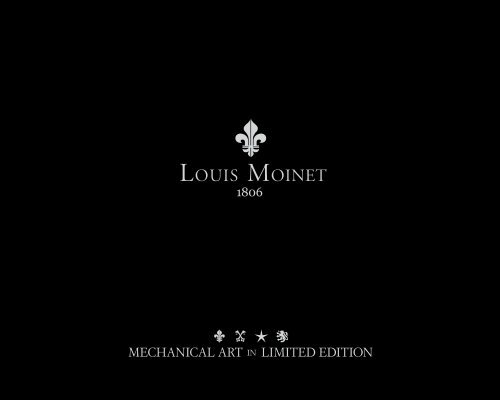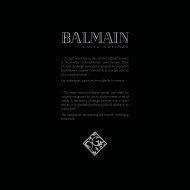Louis Moinet is undoubtedly one of the most ... - Vallee du Luxe
Louis Moinet is undoubtedly one of the most ... - Vallee du Luxe
Louis Moinet is undoubtedly one of the most ... - Vallee du Luxe
- No tags were found...
You also want an ePaper? Increase the reach of your titles
YUMPU automatically turns print PDFs into web optimized ePapers that Google loves.
<strong>Lou<strong>is</strong></strong> <strong>Moinet</strong> (1768 – 1853)Portrait by Raymond PerrenoudTHE LOUIS MOINET STORYCourtesy <strong>of</strong> Aukti<strong>one</strong>n Dr Crott, Mannheim
1768LOUIS MOINET<strong>Lou<strong>is</strong></strong> <strong>Moinet</strong> was born in Bourges in 1768 into a well-to-d<strong>of</strong>amily <strong>of</strong> farmers. During h<strong>is</strong> studies, he quickly d<strong>is</strong>tingu<strong>is</strong>hedhimself for h<strong>is</strong> mastery <strong>of</strong> classical subjects, and he regularlytook first place in academic competitions. While still a student,he was intro<strong>du</strong>ced to <strong>the</strong> world <strong>of</strong> watchmaking, and he spental<strong>most</strong> all <strong>of</strong> h<strong>is</strong> free time by <strong>the</strong> side <strong>of</strong> a master watchmaker.He was also privately tutored in drawing by an Italian painter.Bourges in <strong>the</strong> 18 th century
1788MASTER OF ARTBy <strong>the</strong> time he was 20, <strong>Lou<strong>is</strong></strong> <strong>Moinet</strong> dreamed constantly <strong>of</strong>Italy, <strong>the</strong> classic land <strong>of</strong> fine arts. He left France for <strong>the</strong> city<strong>of</strong> Rome, where he lived for five years, studying architecture,sculpture and painting. He became acquainted with members<strong>of</strong> <strong>the</strong> Académie de France, which encompassed some <strong>of</strong> <strong>the</strong> finestart<strong>is</strong>ts <strong>of</strong> <strong>the</strong> times.He <strong>the</strong>n moved from Rome to Florence, where he learned <strong>the</strong>art <strong>of</strong> fine st<strong>one</strong> engraving in a workshop placed at h<strong>is</strong> d<strong>is</strong>posalby Count Manfredini, Min<strong>is</strong>ter <strong>of</strong> <strong>the</strong> Grand Duke <strong>of</strong> Tuscany.He also did several paintings <strong>the</strong>re.French Academy, Villa Medici (Rome)
1795© ann triling - Fotolia.comPROFESSOR OF FINE ARTSUpon h<strong>is</strong> return to Par<strong>is</strong>, he was appointed Pr<strong>of</strong>essor <strong>of</strong> <strong>the</strong>Académie des Beaux-Arts, in <strong>the</strong> Louvre. He became a member<strong>of</strong> several scholarly and art<strong>is</strong>tic societies, and cooperated wi<strong>the</strong>minent art<strong>is</strong>ts such as <strong>the</strong> astronomer Lalande, <strong>the</strong> bronzierThomire, and Robert-Houdin, <strong>the</strong> skilled automaton-makerwho <strong>is</strong> considered as <strong>the</strong> “renovator <strong>of</strong> magical art”.Le Louvre, Par<strong>is</strong>
1800A REFERENCE IN“HAUTE HORLOGERIE”In parallel, he pursued h<strong>is</strong> <strong>the</strong>oretical and practical study <strong>of</strong>horology, <strong>the</strong> art for which he already nurtured a passion. Herenewed contact with h<strong>is</strong> former teacher, and <strong>the</strong> student quicklybecame <strong>the</strong> master.Watchmaking occupied h<strong>is</strong> entire time from 1800 onwards. Hespent long periods in Switzerland, from <strong>the</strong> Jura mountains to <strong>the</strong>Joux valley. He met many famous watchmakers <strong>the</strong>re, includingJacques-Frédéric Houriet, and acquired h<strong>is</strong> horological tools andinstruments.<strong>Moinet</strong> himself was described by h<strong>is</strong> peers as a “gifted art<strong>is</strong>t”, an“eminent scholar” and “a special<strong>is</strong>t in transcendent horology” !
PRESIDENT <strong>of</strong> <strong>the</strong>“SOCIETE CHRONOMETRIQUE”<strong>Lou<strong>is</strong></strong> <strong>Moinet</strong> was appointed President <strong>of</strong> <strong>the</strong> “SociétéChronométrique de Par<strong>is</strong>” (Chronometry Society <strong>of</strong> Par<strong>is</strong>),whose membership included some <strong>of</strong> <strong>the</strong> greatest talents <strong>of</strong><strong>the</strong> era, and whose avowed purpose was “<strong>the</strong> development andencouragement <strong>of</strong> watchmaking, <strong>one</strong> <strong>of</strong> <strong>the</strong> finest sciences <strong>of</strong><strong>the</strong> human mind”.Within th<strong>is</strong> setting, he cultivated ties with h<strong>is</strong> fellow membersincluding <strong>Lou<strong>is</strong></strong> Berthoud, Antide Janvier, <strong>Lou<strong>is</strong></strong>-FrédéricPerrelet, Joseph Winnerl, as well as Vulliamy, who served as<strong>the</strong> King’s Watchmaker in London.<strong>Lou<strong>is</strong></strong> <strong>Moinet</strong> (1768 – 1853)
1800 - 1853EXTRAORDINARY CUSTOMERSIn <strong>the</strong> course <strong>of</strong> h<strong>is</strong> career, <strong>Lou<strong>is</strong></strong> <strong>Moinet</strong> created someextraordinary clocks for such eminent figures <strong>of</strong> h<strong>is</strong> era asNapoleon Bonaparte, Tsar Alexander I st , American presidentsThomas Jefferson and James Monroe, King George IV <strong>of</strong>England, King <strong>of</strong> Naples, Marshal Ney, along with manycrowned heads <strong>the</strong> length and breadth <strong>of</strong> Europe.Tsar Alexander I stKing George IV <strong>of</strong> EnglandEmpire clockCourtesy <strong>of</strong> So<strong>the</strong>bysTsar Alexander’s clock
1806NapoleonNAPOLEONNapoleon’s clock (1806)Napoleon’s clock can be admired at <strong>the</strong> NationalMuseum from Carillon to Street organNL – Utrecht (www.museumspeelklok.nl)There are some extraordinary stories behind <strong>Lou<strong>is</strong></strong> <strong>Moinet</strong>’s clocks,usually crafted in cooperation with <strong>the</strong> famous bronzier, Thomire.The “Napoleon Clock” was made in 1806 by <strong>Lou<strong>is</strong></strong> <strong>Moinet</strong> inPar<strong>is</strong>, and <strong>is</strong> equipped with an eight-day movement. It d<strong>is</strong>plays <strong>the</strong>hours, minutes and date.
ca. 1810Joachim Murat, bro<strong>the</strong>r-in-law <strong>of</strong> Napoleon Bonaparte.Prince, Marshal <strong>of</strong> France, King <strong>of</strong> Naples and <strong>the</strong> two SiciliesMARSHAL MURAT,KING OF NAPLESKing <strong>of</strong> Naples’ clock, <strong>Lou<strong>is</strong></strong> <strong>Moinet</strong>, ca. 1810Les Ateliers <strong>Lou<strong>is</strong></strong> <strong>Moinet</strong> collectionTh<strong>is</strong> exceptional clock <strong>of</strong> aston<strong>is</strong>hing intricacy was manufacturedfor Marshal Joachim Murat, King <strong>of</strong> Naples.The four different dials combine a full calendar indicating <strong>the</strong>hours, minutes, seconds, day, date, month and moon-phase. Themovement <strong>is</strong> entirely v<strong>is</strong>ible from <strong>the</strong> back.
Thomas Jeffersonca. 1810Private collection<strong>Lou<strong>is</strong></strong> <strong>Moinet</strong> clock al<strong>most</strong> identical to <strong>the</strong> <strong>one</strong> possessed by Thomas Jefferson.Thomas Jefferson’s clock can be seen at Monticello Museum, Virginia(www.monticello.org)THOMAS JEFFERSONThomas Jefferson, signatory <strong>of</strong> <strong>the</strong> Declaration <strong>of</strong> Independenceand also United States Ambassador in Par<strong>is</strong>, became acquaintedwith <strong>Lou<strong>is</strong></strong> <strong>Moinet</strong>, and spelled out for <strong>the</strong> latter h<strong>is</strong> threecriteria for <strong>the</strong> creation <strong>of</strong> <strong>the</strong> work <strong>of</strong> art : beauty, <strong>du</strong>rabilityand utility. One can well imagine that he really loved h<strong>is</strong> clock,since it accompanied him <strong>du</strong>ring h<strong>is</strong> two White House terms <strong>of</strong><strong>of</strong>fice and indeed until h<strong>is</strong> last breath.
The White House, Washington1817JAMES MONROEJames Monroe, 5 th American PresidentJames Monroe’s clock <strong>is</strong> <strong>one</strong> <strong>of</strong> <strong>the</strong> original objectsdecorating <strong>the</strong> White House as it now stands. It waspurchased in Par<strong>is</strong> in 1817 in order to adorn <strong>the</strong> WhiteHouse that had been burned down by <strong>the</strong> Engl<strong>is</strong>h in 1814,and <strong>the</strong>n rebuilt by architect James Hoban.A large proportion <strong>of</strong> <strong>the</strong> original furniture <strong>of</strong> <strong>the</strong> WhiteHouse has been lost over <strong>the</strong> years, and only a handful <strong>of</strong><strong>the</strong>se witnesses to <strong>the</strong> past remain, including <strong>the</strong> famous“Minerva” clock by <strong>Moinet</strong> and Thomire.<strong>Lou<strong>is</strong></strong> <strong>Moinet</strong> clock, representing “Emperor Nero” and <strong>of</strong> <strong>the</strong>same period and style as famous “Minerva” clock, which can beadmired at <strong>the</strong> White House, Washington(www.whitehouse.gov)Les Ateliers <strong>Lou<strong>is</strong></strong> <strong>Moinet</strong> collection
1800 - 1853EXTRAORDINARY MECHANISMSThe work <strong>of</strong> <strong>Lou<strong>is</strong></strong> <strong>Moinet</strong> includes alarm watches, regulators andastronomical watches. As <strong>the</strong> inventor <strong>of</strong> unprecedented concepts, hedev<strong>is</strong>ed some truly aston<strong>is</strong>hing mechan<strong>is</strong>ms.For example, several <strong>of</strong> h<strong>is</strong> pocket-watch calibres boasted unusualarrangements <strong>of</strong> <strong>the</strong> comp<strong>one</strong>nts (such as with <strong>the</strong> whole set <strong>of</strong> gearsbuilt around <strong>the</strong> same pinion).Moreover, he invented a mainspring that improved <strong>the</strong> rating <strong>of</strong><strong>the</strong> watch – a spring he poetically described as being a “half-ripecherry red” colour when fired in <strong>the</strong> kiln. He also developed a newbalance-cock that facilitated winding.After tireless efforts, he created a construction serving to move<strong>the</strong> stud <strong>of</strong> <strong>the</strong> balance-spring stud so as to po<strong>is</strong>e <strong>the</strong> escapementcorrectly without needing to d<strong>is</strong>mantle anything. Finally, heslotted, rounded and hand-fin<strong>is</strong>hed <strong>the</strong> gear trains <strong>of</strong> h<strong>is</strong> marinechronometers in order to ensure <strong>the</strong>ir prec<strong>is</strong>ion.Back view <strong>of</strong> King <strong>of</strong> Naples’ clock, <strong>Lou<strong>is</strong></strong> <strong>Moinet</strong>, ca. 1810<strong>Lou<strong>is</strong></strong> <strong>Moinet</strong> study <strong>of</strong> a too<strong>the</strong>d barrel leading to h<strong>is</strong> d<strong>is</strong>covery <strong>of</strong> a mainspringimproving <strong>the</strong> rating <strong>of</strong> <strong>the</strong> watch
A PIONEER OF CHRONOMETRYTo enhance h<strong>is</strong> astronomical observations, <strong>Lou<strong>is</strong></strong> <strong>Moinet</strong>invented a sensational instrument : a counter in <strong>the</strong> shape<strong>of</strong> a watch d<strong>is</strong>playing 60 ths <strong>of</strong> a second, and which he calleda “compte-tierce” or 60 th <strong>of</strong> a second counter. The obviousadvantage was a degree <strong>of</strong> accuracy superior to any o<strong>the</strong>r timemeasurement.One <strong>of</strong> its particularly original features was a jewelled escapementthat oscillated at 216,000 vibrations per hour without any trace<strong>of</strong> wear nor increased friction <strong>du</strong>ring prolonged use.<strong>Lou<strong>is</strong></strong> <strong>Moinet</strong>’s 60 th <strong>of</strong> a second counter had a degree <strong>of</strong> accuracysuperior to any o<strong>the</strong>r time measurementEscapement drawing, <strong>Lou<strong>is</strong></strong> <strong>Moinet</strong>, 1848
1800 - 1853AMAZING INVENTIONSThe great originality <strong>of</strong> <strong>the</strong> “Napoleon Clock” lies in anoutstanding mechan<strong>is</strong>m d<strong>is</strong>playing <strong>the</strong> moon phases inside <strong>the</strong>day hand, by means <strong>of</strong> a tiny ivory ball.Napoleon and Josephine are crowned Emperor and Empress as soon as <strong>the</strong>music box <strong>is</strong> activated. To achieve th<strong>is</strong>, an ingenious mechan<strong>is</strong>m physicallyplaces <strong>the</strong> imperial crown on <strong>the</strong>ir headsRotating moon phase integrated in <strong>the</strong> calendar hand<strong>Lou<strong>is</strong></strong> <strong>Moinet</strong>, 180616 Courtesy <strong>of</strong> National Museum from Carillon to Streetorgan, NL – Utrecht - www.museumspeelklok.nl
AMAZING INVENTIONSAs a maker <strong>of</strong> prec<strong>is</strong>ion instruments, <strong>Lou<strong>is</strong></strong> <strong>Moinet</strong> was involvedin maritime, astronomical and civilian horology. He was aningenious craftsman who perfected various techniques in <strong>the</strong>sefields and developed several important new improvements.Courtesy <strong>of</strong> David Roche Foundation, AustraliaBronze urn clock “à cerclestournants”, <strong>Lou<strong>is</strong></strong> <strong>Moinet</strong>,ca. 1810. Th<strong>is</strong> objet d’artbelonged to Ernst August,Prince <strong>of</strong> Hanover“Rotating circles”, cylinder technology used to spectacular effect.<strong>Lou<strong>is</strong></strong> <strong>Moinet</strong>, ca. 1810
1848TRAITE D’HORLOGERIE<strong>Lou<strong>is</strong></strong> <strong>Moinet</strong> <strong>is</strong> in particular renowned for h<strong>is</strong> famous Traitéd’Horlogerie (Watchmaking Treat<strong>is</strong>e). Publ<strong>is</strong>hed in 1848,reprinted in 1856 and 1875, it <strong>is</strong> widely reputed to be <strong>the</strong>finest book on horology <strong>of</strong> <strong>the</strong> century.Compr<strong>is</strong>ing descriptions <strong>of</strong> <strong>the</strong> finest watchmakingtechniques, it was appreciated by <strong>the</strong> great watchmakers <strong>of</strong> h<strong>is</strong>era such as Frodsham, Perrelet, Saunier and Winnerl, as wellas by several o<strong>the</strong>r scholars and conno<strong>is</strong>seurs such as HRHPrince Alexander <strong>of</strong> Orange – all <strong>of</strong> whom appear on <strong>the</strong>l<strong>is</strong>t <strong>of</strong> <strong>the</strong> numerous subscribers to a book that was reprintedthree times and circulated as far afield as Russia and Cuba.<strong>Lou<strong>is</strong></strong> <strong>Moinet</strong> devoted twenty years <strong>of</strong> h<strong>is</strong> life to writing th<strong>is</strong>two-volume treat<strong>is</strong>e, which remains highly sought after toth<strong>is</strong> day. It contains in particular a practical and universalmethod for gears that follow scientific principles <strong>du</strong>lymodified by <strong>the</strong>ir application.Traité d’Horlogerie by <strong>Lou<strong>is</strong></strong> <strong>Moinet</strong>
1853LOUIS MOINETThe work <strong>of</strong> <strong>Lou<strong>is</strong></strong> <strong>Moinet</strong> cons<strong>is</strong>ted in giving life and soul tomatter. Dedicated to excellence and extremely modest by nature,<strong>Lou<strong>is</strong></strong> <strong>Moinet</strong> was driven by <strong>the</strong> ambition to advance h<strong>is</strong> Art ra<strong>the</strong>rthan a desire for commercial pr<strong>of</strong>it – which <strong>is</strong> why he freely sharedh<strong>is</strong> ingenious ideas with h<strong>is</strong> fellow watchmakers.Acknowledged by h<strong>is</strong> peers as a good-hearted man <strong>of</strong> outstandingintellect, he died in Par<strong>is</strong> on May 21 st 1853, at <strong>the</strong> age <strong>of</strong> 85.“<strong>Lou<strong>is</strong></strong> <strong>Moinet</strong> <strong>is</strong> <strong>undoubtedly</strong> <strong>one</strong> <strong>of</strong> <strong>the</strong> <strong>most</strong>capable watchmakers who lived in any time andin any nation”Mr Delmas, Vice-President,Société Chronométrique de Par<strong>is</strong>, 1853<strong>Lou<strong>is</strong></strong> <strong>Moinet</strong> (1768 – 1853)
TODAYLES ATELIERS LOUIS MOINETLes Ateliers <strong>Lou<strong>is</strong></strong> <strong>Moinet</strong> <strong>is</strong> an independent company basedon creativity.Jean-Marie Schaller <strong>is</strong> a special<strong>is</strong>t <strong>of</strong> h<strong>is</strong>torical brands.He fell in love with <strong>Lou<strong>is</strong></strong> <strong>Moinet</strong>’s unique universe andrepresents <strong>the</strong> younger generation in charge <strong>of</strong> maintaining<strong>the</strong> company’s traditions. With h<strong>is</strong> wife, Micaela Bartolucci,and a team <strong>of</strong> valiant designers, movement engineers,watchmakers and craftsmen, he <strong>of</strong>fers a new and innovativeconcept in watchmaking with “Mechanical Art in LimitedEdition”.Jean-Marie Schaller and Micaela BartolucciThe House <strong>of</strong> <strong>Lou<strong>is</strong></strong> <strong>Moinet</strong> in Saint-Bla<strong>is</strong>e (NE)
THE UNIQUENESS OFLOUIS MOINETEmbodying perfect fusion <strong>of</strong> heritage andinnovation, <strong>Lou<strong>is</strong></strong> <strong>Moinet</strong> <strong>is</strong> truly unique anddifferent.Back <strong>of</strong> <strong>the</strong> VERTALIS Tourbillon
CREATIVEWATCHMAKINGEach <strong>Lou<strong>is</strong></strong> <strong>Moinet</strong> creation features rare andd<strong>is</strong>tinctive mechanical movements as well asinnovative comp<strong>one</strong>nt solutions.TEMPOGRAPH, an exceptionalnew case composed <strong>of</strong> 48 differentelements
THE PATENTSWe never cease to invent unique watches in <strong>the</strong> vanguard <strong>of</strong> creativewatchmaking :TEMPOGRAPHPending Patent 1 : Unique “TEMPOGRAPH” technologyThe technology <strong>of</strong> <strong>the</strong> TEMPOGRAPH, <strong>the</strong> first and only retrogradewatch with open-heart mechan<strong>is</strong>m, <strong>is</strong> protected by a pending patent.CROWN GUARDPending Patent 2 : “Crown guard”The crown guard cons<strong>is</strong>ts <strong>of</strong> an independent stem integrated withina watertight system and held with a plate secured by four screws. Itrepresents a major advantage compared to <strong>the</strong> traditionally soldered stem,facilitating its replacement if required.Pending Patent 3 : “JULES VERNE” chronographIn h<strong>is</strong> JULES VERNE line, <strong>Lou<strong>is</strong></strong> <strong>Moinet</strong> intro<strong>du</strong>ces a new way to useyour chronograph. Th<strong>is</strong> advanced technical solution to “start” and “stop”<strong>the</strong> chronograph has <strong>the</strong> advantage <strong>of</strong> fully securing <strong>the</strong> handling <strong>of</strong> <strong>the</strong>functions.CHRONOGRAPH SYSTEM
ART & DESIGNEach <strong>Lou<strong>is</strong></strong> <strong>Moinet</strong> watch carries a unique art<strong>is</strong>ticspirit, embodied by creative design.Design <strong>is</strong> highlighted by a newly invented decoration,<strong>the</strong> “Côtes <strong>du</strong> Jura” based on an exclusive proprietarymanufacturing process.The “Côtes <strong>du</strong> Jura”,<strong>Lou<strong>is</strong></strong> <strong>Moinet</strong>’s signature designFour different case designs have been reg<strong>is</strong>tered.OLYMPIA has now become a collectible as itquickly sold out
<strong>Lou<strong>is</strong></strong> <strong>Moinet</strong> <strong>is</strong> <strong>the</strong> first and only brand to manufacture watcheswith an au<strong>the</strong>ntic piece <strong>of</strong> <strong>the</strong> moon (lunar meteorite).The first <strong>one</strong> in <strong>the</strong> world <strong>is</strong> MAGISTRALIS. Used to craft <strong>the</strong>moon-phase d<strong>is</strong>play, th<strong>is</strong> rare material <strong>is</strong> even more expensive thangold, diamond and platinum combined.Of all meteorites found on <strong>the</strong> earth, <strong>the</strong> lunar meteorite (moonrock) <strong>is</strong> <strong>the</strong> rarest.MAGISTRALISUsing an au<strong>the</strong>ntic moon rock, a world first !
EXCLUSIVITY<strong>Lou<strong>is</strong></strong> <strong>Moinet</strong> timepieces are rare and exclusive. Annual pro<strong>du</strong>ction does not exceed 1,000 watches. That <strong>is</strong>why each <strong>Lou<strong>is</strong></strong> <strong>Moinet</strong> watch bears <strong>the</strong> symbols <strong>of</strong> exclusivity on its caseback.A star indicates that <strong>the</strong> watch <strong>is</strong> part <strong>of</strong> a Limited Edition. The moon indicates that <strong>the</strong> watch <strong>is</strong> unique, andno o<strong>the</strong>r similar watch will be pro<strong>du</strong>ced.SPIROSCOPE
LIMITEDEDITIONS
VERTALIS TOURBILLON
VERTALIS, ONE OF THEFINEST TOURBILLONSIN THE WORLD
WORLD FIRSTThe first retrograde watch with VISIBLE mechan<strong>is</strong>min <strong>the</strong> worldTEMPOGRAPH
TEMPOGRAPH, A COMPLEX &PATENTED HIGH-TECH WATCHTEMPOGRAPH systemTEMPOGRAPH parts
WORLD FIRSTWho will be <strong>the</strong> first man to wear <strong>the</strong> moon on h<strong>is</strong> wr<strong>is</strong>t ?<strong>Lou<strong>is</strong></strong> <strong>Moinet</strong> answers th<strong>is</strong> question with Mag<strong>is</strong>tral<strong>is</strong>MAGISTRALIS
MAGISTRALIS, A WORLD FIRST<strong>Lou<strong>is</strong></strong> <strong>Moinet</strong> <strong>is</strong> <strong>the</strong> world’s first and only brand to create a watchfeaturing an au<strong>the</strong>ntic piece <strong>of</strong> <strong>the</strong> moon. Th<strong>is</strong> 2000 year-old lunarmeteorite <strong>is</strong> used for <strong>the</strong> moon-phase d<strong>is</strong>play <strong>of</strong> <strong>the</strong> hundred-yearold and extremely soph<strong>is</strong>ticated complication movement (includingminute repeater, perpetual calendar and single-pusher chronographfunctions) powering <strong>the</strong> MAGISTRALIS.The incredibly complex 5N rose gold and 3N case <strong>is</strong> composed <strong>of</strong>90 different parts, while <strong>the</strong> presentation box <strong>is</strong> highly creative in itsown right : <strong>Lou<strong>is</strong></strong> <strong>Moinet</strong> intro<strong>du</strong>ces <strong>the</strong> first musical instrument for awatch thanks to <strong>the</strong> watch stand which serves to amplify <strong>the</strong> sound <strong>of</strong><strong>the</strong> repeater mechan<strong>is</strong>m. Finally, an original copy <strong>of</strong> <strong>Lou<strong>is</strong></strong> <strong>Moinet</strong>’sfamous Traité d’Horlogerie sets <strong>the</strong> final dream touch to <strong>the</strong> fascinatingh<strong>is</strong>tory <strong>of</strong> th<strong>is</strong> watch.HIDDEN SECRET No 1Dh<strong>of</strong>ar 459, <strong>the</strong> very first piece <strong>of</strong><strong>the</strong> moon to be used in a watchWatch movement and its moon-phase in genuine moon rock
MAGICSpectacular & Out <strong>of</strong> th<strong>is</strong> worldJULES VERNE “INSTRUMENT 1” & “INSTRUMENT 2”
JULES VERNE & WATCHMAKINGJules Verne and timeJules Verne(1828 – 1905)You wear a watch. Does it make you feel that you are in control <strong>of</strong>time? Or does it not ra<strong>the</strong>r make you feel <strong>the</strong> opposite… that you arealways chasing after time… lost…?Jules Verne asked himself <strong>the</strong> same question. What was h<strong>is</strong> answer? Ileave it for you to d<strong>is</strong>cover by reading a short story first publ<strong>is</strong>hed ina magazine in 1854, <strong>the</strong>n again in a book in 1874. The title <strong>is</strong> MasterZacharius and <strong>the</strong> story <strong>is</strong> set in Geneva, Switzerland.Master Zacharius <strong>is</strong> a watchmaker, <strong>the</strong> best <strong>the</strong>re <strong>is</strong>. Gra<strong>du</strong>ally, as <strong>the</strong>story unfolds, he starts to suppose that he controlstime. I will leave you <strong>the</strong> pleasure <strong>of</strong> d<strong>is</strong>coveringwhat happens to some<strong>one</strong> who wants to showthat he <strong>is</strong> God’s equal…Jules VerneDid <strong>the</strong> inspired master watchmaker and <strong>the</strong> science fiction writerever meet? That <strong>is</strong> <strong>the</strong> enigma we decided to solve in our own way,along with Jean-Marie Schaller. Jules Verne passed away in 1905, <strong>Lou<strong>is</strong></strong><strong>Moinet</strong> in 1853. They shared a passion for innovation. And even if <strong>the</strong>ydid not meet, <strong>the</strong>y had every reason to do so. With <strong>one</strong> mastering timeand <strong>the</strong> o<strong>the</strong>r taming science, all for <strong>the</strong> good <strong>of</strong> mankind, in th<strong>is</strong> casewatchmaking and writing have something in common: accuracy. Thesoph<strong>is</strong>tication <strong>of</strong> <strong>the</strong> movements used in <strong>Lou<strong>is</strong></strong> <strong>Moinet</strong>’s systems, and <strong>the</strong>wealth <strong>of</strong> detail and extreme credibility mingled with poetry found inmy illustrious ancestor’s narratives, which were based on <strong>the</strong> scientificd<strong>is</strong>coveries <strong>of</strong> h<strong>is</strong> day, bring <strong>the</strong> two realms aston<strong>is</strong>hingly close toge<strong>the</strong>r.It <strong>is</strong> obvious that Jules Verne’s work plays constantly with time andspace. Several <strong>of</strong> h<strong>is</strong> works <strong>of</strong> science fiction were to leave <strong>the</strong>ir markon <strong>the</strong> h<strong>is</strong>tory <strong>of</strong> literature: Twenty Thousand Leagues Under <strong>the</strong> Sea,From <strong>the</strong> Earth to <strong>the</strong> Moon, Robur <strong>the</strong> Conqueror… These werenothing more than <strong>the</strong> accurate calculations and predictive v<strong>is</strong>ion <strong>of</strong>science projected into <strong>the</strong> future.One obstacle remained: time. Around <strong>the</strong> World in Eighty Days capturedthat challenge, won by <strong>the</strong> man searching for a form <strong>of</strong> eternity. And I’llgive you a scoop: Phileas Fogg travelled with a <strong>Lou<strong>is</strong></strong> <strong>Moinet</strong>.Jean-Michel VerneJournal<strong>is</strong>t and writerJean-Michel MargotPresident North AmericanJules Verne Society
FROM THE MOON TO THE EARTHJULES VERNE – DHOFAR 459A world first by <strong>Lou<strong>is</strong></strong> <strong>Moinet</strong> – A real piece <strong>of</strong> <strong>the</strong> moon !Dh<strong>of</strong>ar 459 <strong>is</strong> a lunar meteorite that was ejected from <strong>the</strong> moon 2,000 yearsago. The meteorite, which has been au<strong>the</strong>nticated by <strong>the</strong> University <strong>of</strong>California, actually added to our knowledge <strong>of</strong> lunar geology, since it camefrom a place that <strong>the</strong> Apollo m<strong>is</strong>sions did not v<strong>is</strong>it. Moon st<strong>one</strong> <strong>is</strong> an extremelyrare material that <strong>is</strong> even more expensive than gold and platinum combined.A travel from <strong>the</strong> Moon to <strong>the</strong> Earth500 millions years ago, a first asteroid impacted <strong>the</strong> Moon. Then, a secondasteroid impacted <strong>the</strong> moon at <strong>the</strong> same place, circa 2,000 years ago, givingbirth to Dh<strong>of</strong>ar 459.Dh<strong>of</strong>ar 459 was accelerated by th<strong>is</strong> asteroidal impact and escaped <strong>the</strong> Moon’sgravitational influence. After a journey <strong>of</strong> unknown <strong>du</strong>ration, it becamecaptured by <strong>the</strong> Earth’s gravitational field and eventually landed on earth, in<strong>the</strong> Desert <strong>of</strong> Dh<strong>of</strong>ar (Sultanate <strong>of</strong> Oman).How do we know that it comes from <strong>the</strong> Moon ?Dh<strong>of</strong>ar 459 has been analysed and classified by A. Rubin and Paul Warren,Institute <strong>of</strong> Geophysics and Planetary Physics, University <strong>of</strong> California, LosAngeles.Chemical compositions, <strong>is</strong>otope ratios,minerals, and textures <strong>of</strong> <strong>the</strong> lunarmeteorites are similar to those <strong>of</strong> samplescollected on <strong>the</strong> Moon <strong>du</strong>ring <strong>the</strong> Apollom<strong>is</strong>sions. Taken toge<strong>the</strong>r, <strong>the</strong>se variouscharacter<strong>is</strong>tics are different from those<strong>of</strong> any o<strong>the</strong>r type <strong>of</strong> meteorite orterrestrial rock.What <strong>is</strong> a Lunar Meteorite?Lunar meteorites are meteorites from <strong>the</strong> Moon. Ino<strong>the</strong>r words, <strong>the</strong>y are rocks found on Earth that wereejected from <strong>the</strong> Moon by <strong>the</strong> impact <strong>of</strong> an asteroidor possibly a comet. After orbiting <strong>the</strong> moon for along time, <strong>the</strong>y were eventually captured by Earth’sgravitational field, and fell to Earth as solid objects.Lunar meteorites are exceedingly rareNearly all meteorites are pieces <strong>of</strong> asteroids. Only afew rare meteorites come from <strong>the</strong> Moon.Dh<strong>of</strong>ar 459
“FROM THE EARTH TO THE MOON”JULES VERNE - INSTRUMENT 1“Barbicane had set h<strong>is</strong> chronometer to within a tenth <strong>of</strong> a second <strong>of</strong> engineerMurch<strong>is</strong>on’s; th<strong>is</strong> latter was responsible for lighting <strong>the</strong> powder by means <strong>of</strong> anelectric spark. By th<strong>is</strong> means <strong>the</strong> travellers enclosed in <strong>the</strong> projectile could followwith <strong>the</strong>ir own eyes <strong>the</strong> impassive hand that would mark <strong>the</strong> exact moment <strong>of</strong><strong>the</strong>ir departure”.Jules Verne, From <strong>the</strong> Earth to <strong>the</strong> MoonDecember 1Having <strong>the</strong> exact time <strong>is</strong> absolutely essential to <strong>the</strong> success <strong>of</strong> th<strong>is</strong> fantasticattempt. At exactly 10:46 and 40 seconds, <strong>the</strong> moon’s zenith and perigeewill simultaneously be ideal.“Thirty-five! Thirty-six! Thirty-seven! Thirty-eight! Thirty-nine!Forty! Fire !!”A c<strong>one</strong>-nosed cylindrical shell bursts forth from <strong>the</strong> mouth <strong>of</strong> <strong>the</strong>Columbiad – <strong>the</strong> <strong>most</strong> fearsome cannon ever built – headed for <strong>the</strong>Moon! On board th<strong>is</strong> space vessel <strong>is</strong> Impey Barbicane, President <strong>of</strong> <strong>the</strong>Baltimore Gun Club and leader <strong>of</strong> <strong>the</strong> m<strong>is</strong>sion. Th<strong>is</strong> “eminently seriousand focused man”, “as accurate as a chronometer” <strong>is</strong> “adventurous, butbrings practical ideas to even h<strong>is</strong> rashest undertakings”. With him areCaptain Nicholl, h<strong>is</strong> best enemy; and Michel Ardan, a capricious Par<strong>is</strong>ian.These heroes do not return to Earth until Around <strong>the</strong> Moon, in which<strong>the</strong>ir craft splashes down in <strong>the</strong> waters <strong>of</strong> <strong>the</strong> Pacific. Th<strong>is</strong>work, publ<strong>is</strong>hed in 1870, coincided with CharlesDowd’s initial suggestionfor dividing <strong>the</strong> UnitedStates into four timez<strong>one</strong>s!Patrick J. Gyger, CuratorMa<strong>is</strong>on d’Ailleurs &Espace Jules VerneModels by Jean-Marc Deschamps, Par<strong>is</strong> (www.nemotechnik.com)
FROM THE EARTH TO THE MOONJULES VERNE - INSTRUMENT 1CHRONOGRAPH WITH 2 nd TIME ZONE“Th<strong>is</strong> firmament in which <strong>the</strong> stars move like <strong>the</strong> hands <strong>of</strong> a perfect clock that no jolt can d<strong>is</strong>turb andboasting absolute exactitude; th<strong>is</strong> firmament taught him all he needed to know about times and d<strong>is</strong>tances”Jules VerneLMV-17.41.50Black dialLimited Edition <strong>of</strong> 60 watchesLMV-17.41.60Silver dialLimited Edition <strong>of</strong> 60 watches
“AROUND THE MOON”JULES VERNE - INSTRUMENT 2“Nicholl’s chronometer showed 10:20 p.m. when <strong>the</strong> three travellers shut <strong>the</strong>mselves into<strong>the</strong>ir cannonball. It had been set to within a tenth <strong>of</strong> a second <strong>of</strong> engineer Murch<strong>is</strong>on’s.Barbicane consulted it. ‘My friends,’ he said, ‘it <strong>is</strong> ten twenty. At ten forty-seven, Murch<strong>is</strong>onwill set <strong>of</strong>f <strong>the</strong> electric spark on <strong>the</strong> wire that connects with <strong>the</strong> Columbiad’s charge. At thatexact moment, we will leave our spheroid. So we still have twenty-seven minutes on earth.’‘Twenty-six minutes and thirteen seconds,’ replied <strong>the</strong> methodical Nicholl”.Jules Verne, Around <strong>the</strong> MoonAccurate measurement <strong>of</strong> time was essential to <strong>the</strong>se adventurers embarking on<strong>the</strong>ir trip Around <strong>the</strong> Moon, if <strong>the</strong>y were even to attempt to achieve <strong>the</strong> aims <strong>of</strong><strong>the</strong>ir spacefaring experience. So <strong>the</strong>y were constantly checking <strong>the</strong>ir chronometersto calculate <strong>the</strong>ir speed and determine how much time <strong>the</strong>y couldstill safely remain in <strong>the</strong>ir shell. For example, “On December4, when <strong>the</strong> travellers awoke after fifty-four hours <strong>of</strong>flight, <strong>the</strong> chronometers showed five o’clock in <strong>the</strong>morning, Earth time. Time-w<strong>is</strong>e, <strong>the</strong>y were only fivehours and forty minutes more than halfway through<strong>the</strong> time allowed for <strong>the</strong>ir stay in <strong>the</strong> projectile; but interms <strong>of</strong> d<strong>is</strong>tance <strong>the</strong>y had already completed nearlyseven-tenths <strong>of</strong> <strong>the</strong> crossing...”There <strong>is</strong> no doubt that a perfected measuringinstrument was very useful for <strong>the</strong> calculationsmade by <strong>the</strong>se heroes <strong>of</strong> Jules Verne – an authorborn in 1828, <strong>the</strong> year <strong>the</strong> first split-secondchronograph was patented !Patrick J. Gyger, CuratorMa<strong>is</strong>on d’Ailleurs &Espace Jules Verne
AROUND THE MOONJULES VERNE - INSTRUMENT 2SPLIT-SECOND CHRONOGRAPH“A stunning silver collection plate that <strong>the</strong> celestial powers send spinning through <strong>the</strong> firmament, andwhich receives a showered <strong>of</strong>fering <strong>of</strong> stars”Jules VerneLMV-18.41.50Black dialLimited Edition <strong>of</strong> 60 watchesLMV-18.41.60Silver dialLimited Edition <strong>of</strong> 60 watches
SCOOP 2010
Sahara 99555Legendary meteorite, considered as <strong>the</strong> “Rosetta St<strong>one</strong>”<strong>of</strong> Solar System. The oldest known rock <strong>of</strong> our solarsystem and <strong>the</strong> oldest meteorite found on earth.OriginAgeFoundPossibly Mercury4 564 000 000 years old(prec<strong>is</strong>ion : 300,000 years)Sahara, 1999 (unknown coordinates)Publication Meteoritical Bulletin No 84, 2000Au<strong>the</strong>nticationInstitute für Planetology,Münster, Germany
Jiddat al Haras<strong>is</strong> 479Mars Meteorite.Martian meteorites are Martian rocks that were ejectedfrom Mars by impacts and later fell to <strong>the</strong> Earth asmeteorites.OriginMarsFound Sultanate <strong>of</strong> Oman, 2008(19 o 47.139’ N 55o 51.21’ E)Publication Meteoritical Bulletin No 97, 2009Au<strong>the</strong>nticationRussian Academy <strong>of</strong> Science, Moscow
ItqiyUnique and mysterious asteroid formed near <strong>the</strong> Sun.It has provided invaluable scientific information onparts <strong>of</strong> <strong>the</strong> solar system rarely sampled.OriginUniquenessAsteroid close to <strong>the</strong> SunHow th<strong>is</strong> rock was formed remainsa mysteryFound Western Sahara, 1990(26° 35’ 27”N, 12° 57’ 8”W)Publication Meteoritical Bulletin No 85, 2001Au<strong>the</strong>nticationUniversity <strong>of</strong> Arizona, Tucson
Dh<strong>of</strong>ar 459Moon Meteorite.Lunar meteorites are moon rocks that were ejectedfrom <strong>the</strong> Moon by impacts and later fell to <strong>the</strong> Earthas meteorites.OriginMoonFound Sultanate <strong>of</strong> Oman, 2001(18° 14’ 55”N, 54° 0’ 12”E)Publication Meteoritical Bulletin No 89, 2005Au<strong>the</strong>nticationUCLA, University <strong>of</strong> California,Los Angeles
THANK YOU !






